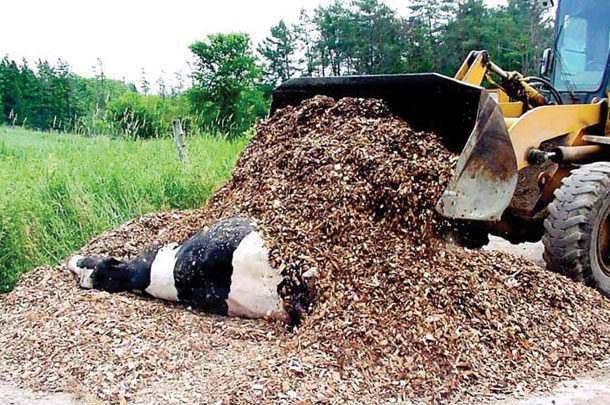Managing livestock mortality, or deadstock, can be challenging. First, there is the loss of the animal, which is an economic loss, and second, it is important that disposal be as efficient and effective as possible.
Livestock farmers, the butcher industry, fisheries, public works and environmental managers need a convenient, socially and environmentally acceptable, biosecure way of disposing mortality.
As traditional methods of disposal – burial, incineration and rendering – are unavailable and cost increases, farmers, butchers and public works departments are turning to composting to find biosecure, inexpensive and environmentally safe disposal. When considering options, preference should be given to processes that recover non-diseased animal byproducts for food or feed for animals and render them into commercial products.
Many people don’t realize that composting is a legal and acceptable way of disposing of these materials; however, the nutrients from animal disposal need to be accounted for in nutrient management plans for CAFOs. Composting can be accomplished in compliance with environmental regulations in most states; however, California law allows the composting of poultry but not mammals.
There are many good reasons to compost mortality and animal byproducts. The heat of the composting process kills pathogens, and it can be implemented any time of the year, even when the ground is frozen. Existing farm equipment is generally all you need.
The process is relatively odor-free and all sizes of animals can be composted, including placental membranes and other tissue, paunch manure and other parts. It requires relatively low labor and management needs and does not cost as much as other methods.
All you need to compost is a dry site, convenient but out of the way, and a stock pile of coarse carbon. The process of making compost is the opposite of making silage. In silage production, the air is squeezed out so the silage does not degrade. In composting, the microbes that degrade the carcass need oxygen to live and break down the organic material.
People that manage road-kill on state and local roads have been most successful with composting because the only carbon they have available is municipal wood chips, and their nitrogen source is dead deer, bear, skunks, raccoons, moose, elk and buffalo. They envelop the animals in carbon and leave them to compost with passive aeration. No turning required. It is easy, effective and inexpensive.
Here are the key steps of static pile carcass composting:
- Select a site that is well-drained, at least 200 feet from watercourses, sinkholes, seasonal seeps or other landscape features that indicate the area is hydrologically sensitive.
- Lay a 24-inch base of bulky, absorbent organic material containing sizable pieces 2 to 3 inches long. The base should be 10 to 12 feet wide and as long as space permits. The 24-inch base should be utility and municipal wood chips, which work well as the base material because they allow air to flow into the pile. Coarse farm materials can work in the base as well. Make sure base is large enough to allow for 2 feet of clearance around the carcass.
- Lay the animal in the center of the bed. Lance the rumen or stomach to avoid bloating and possible explosion. Explosive release of gases can result in odor problems, and it will blow the cover material off the composting carcass.
- Cover carcass with 24 inches of dry, high-carbon material: old silage, wood shavings, dry stall bedding, bedded pack, hay/straw, chopped corn stalk or cobb, nut or seed hull.
- For smaller animals and butcher residual, lay the 24-inch base, then add a 12- to 15-inch layer of animals or residuals, then cover with a 12- to 15-inch layer of wood chips, add another animal layer and cover with 2 feet of wood chips to cap the pile. The finished section should be 5 to 9 feet high.
- Add water as necessary. Although carcasses supply considerable moisture, it may not be sufficient to support decomposition in very dry periods or climates. Add moisture to the carbon material as the pile is being built; it should feel and look damp, and moisture content should be 40 to 60 percent.
- Let the pile sit for four to 12 months. The flesh of a 1,200-pound cow will degrade in three to four months in a well-built pile. Temperatures in the pile should reach between 120ºF and 150ºF in 24 hours and sustain those temperatures through the active process.
- Turning note: Carcass and butcher residual piles should not be turned early in the process unless there are no neighbors that would be affected by odors. Odor is a big issue most of the time. After three months, turning is an option and will speed the curing process.
Reuse the composted material for another carcass compost pile or remove large bones and land-apply to feed crops. Site cleanliness is the most important aspect of composting; it deters scavengers, helps control odors and keeps good neighbor relations. If piles are built correctly, composting is a great option and allows the carcass to be recycled back into a soil amendment.
Mass casualty and emergency response composting
Death of large numbers of animals can occur for many reasons, including fire, lightning, barn collapse, power interruptions, disease outbreaks, floods, fish kills and marine mammal beaching. Composting can provide a timely solution for any amount of animals if space and carbonaceous bulking materials are available. Finding enough appropriate carbon sources can be tough in emergency situations, so those preparing should have a list of possible sources.
Starting in December 2014 and continuing through June 2015, there was an outbreak of highly pathogenic avian influenza (HPAI) in the U.S. More than 48 million turkeys and chickens were affected in 223 locations in 15 states. Although this was a tough situation to respond to, many of the birds, litter, eggs and affected feed were effectively managed through composting.
The response was quick, with Animal and Plant Health Inspection Service (APHIS) coordinating as outbreaks emerged in different locations from the West to the Midwest. In some cases, emergency response plans were in place, but for the most part people and pieces of plans still had to be developed. Emergency response plans should be developed with multiple disposal tools so that response time will be quick and effective.
An effort to gather farmers, veterinarians, community and state and federal agencies to continue the planning and collaboration in the U.S. and the world is the upcoming Fifth International Symposium. Managing Animal Mortalities, Products, Byproducts and Associated Health Risk: Connecting Research, Regulations and Response will be held in Lancaster, Pennsylvania, Sept. 28 to Oct. 1. For more information, go to the website. PD
Jean Bonhotal is the director and Mary Schwarz is an extension support specialist at Cornell Waste Management Institute. Go to the website to learn more about CWMI.







